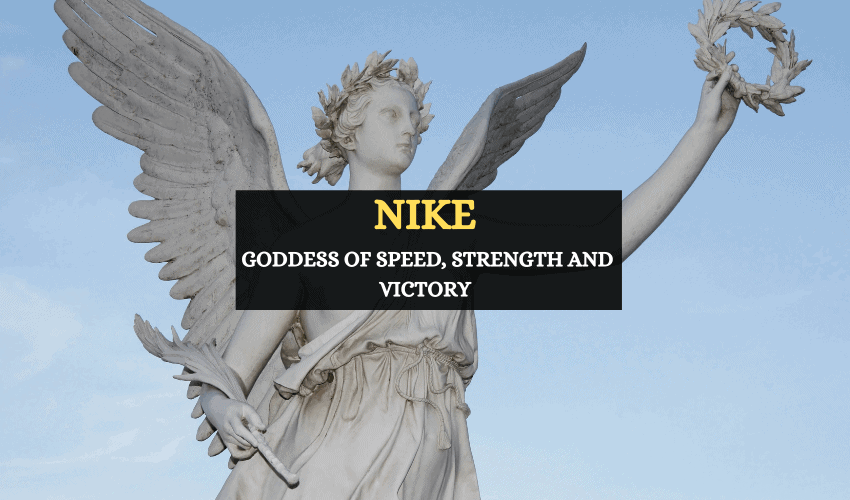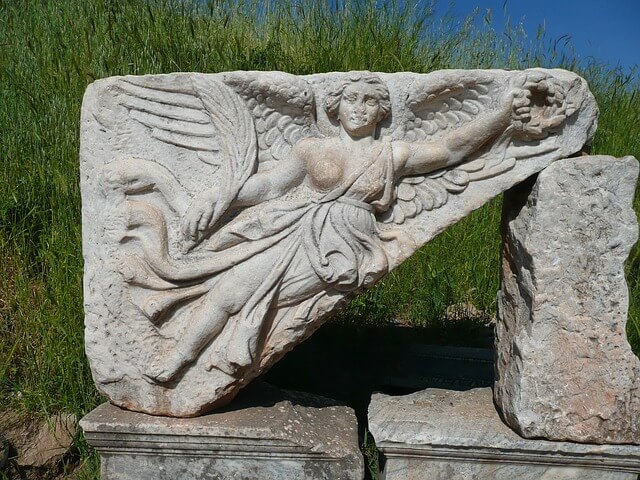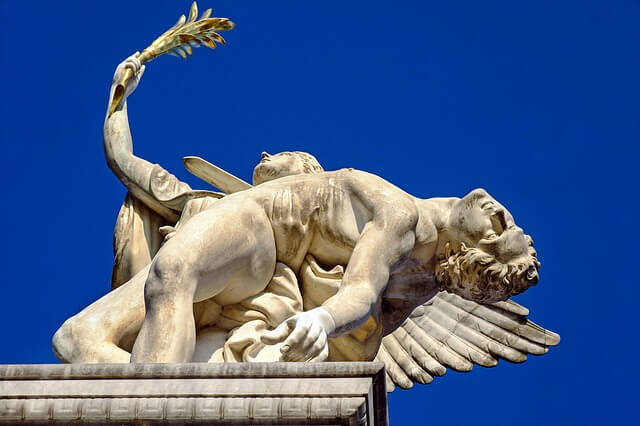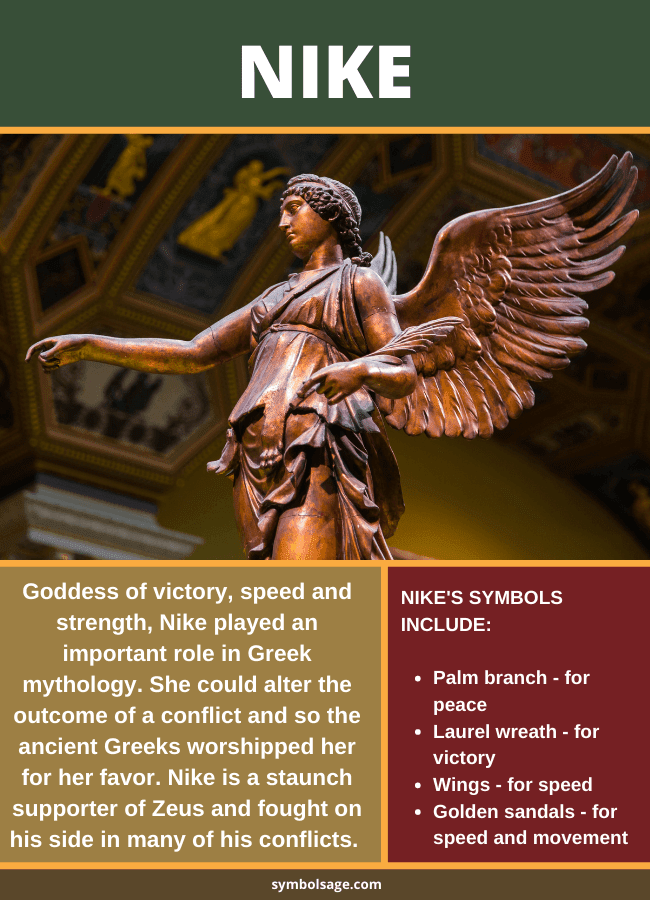
Table of Contents
Greek mythology is full of wars, conflicts, losers, and victors, and Nike played an essential role in these conflicts. Also known as the ‘Winged Goddess’, Nike is the goddess of victory, speed and strength. Having Nike’s favor was a great advantage since she could determine the outcome of the event. Nike has also had a strong influence on modern culture, with evidence of her influence around the globe.
Here’s a closer look at her myth and her symbols.
Who was Nike?

Nike was one of the children of the goddess Styx (the personification of the underworld river also called Styx). Styx and the Titan Pallas had four children: Zelus (rivalry), Kratos (strength), Bia (force), and Nike (victory).
In her depictions in Greek vase paintings, Nike appears as a winged goddess with a palm branch symbolizing victory. Other works show her with a wreath or a crown to honor victors. In some cases, she also appears with a lyre to play a song of victory.
Nike in the Titanomachy
Styx was the first deity to offer her children to the cause of the Olympian gods in the Titanomachy, which was the war between the Olympias and the Titans for the rule of the universe. Oceanus, who was Styx’s father, instructed her to take her children to Mount Olympus and pledge to the cause of Zeus.
That way, they could remain under Zeus’ protection and live in the heavens with the gods. From then onwards, Nike and her siblings would stay by Zeus’ side and help him win the war.
Nike and Zeus
Nike lived on Mount Olympus and became the divine charioteer of Zeus. She served as his charioteer in the War of Titans and the war against the monster Typhon. When Typhon had made most of the gods flee, Nike was the only one to stay with Zeus. In some myths, Nike gives Zeus a speech to help him stand up and keep fighting for victory. Some depictions of the winged goddess show her next to the throne of Zeus on Mount Olympus.
Nike in Greek Mythology

Besides her role with Zeus, Nike plays a central role in Greek mythology as the goddess of victory in wars and contests. Several authors wrote about her influence in blessing the victors with her favor. She’s also referred to as the goddess of speed and the herald who announced victories.
In some myths, she is the deity who guides the horses of the heroes in their battles and feats. It is common for her to appear as the companion of Zeus and Athena. Some authors have referred to her as one of Athena’s attributes. Their depictions have many similarities, but you can tell Nike apart from Athena due to her sacred objects.
Nike’s Symbols
Nike is often depicted with the following symbols, considered sacred to her.
1. Palm Branch
This item symbolized peace and has been used since ancient times as such. It can also symbolize victory because after every conflict, there’s peace and victory.
2. Wings
Nike’s wings symbolized her role as goddess of speed. She’s one of the few goddesses to be depicted with wings making her easily recognizable. She could easily move in the battlefield.
3. Laurel Wreath
Nike’s depictions often feature her holding a laurel wreath, a symbol of victory and achievement. Some portrayals show her about to crown a victor with the wreath, as it was Nike who would confer either victory or defeat upon a person.
4. Golden Sandals
Nike wears sandals made of gold, which are sometimes said to be the winged sandals of Hermes. These associate her with speed and movement.
Nike’s Cult and Worship
Nike had several cults throughout Greece, and warriors never faced battle without first praying and offering sacrifices to the goddess. Her principal place of worshipping was Athens, and her depictions and statues there show her without wings. In some accounts, the Athenians did this in hopes that the goddess would never fly away and would remain to bless them with victories. People believed that the blessing of Nike would grant them the ability to defeat everything and always be victorious.
In Greece, there are a variety of statues and paintings of Nike in which she appears alone, or with either Zeus or Athena. People erected statues of the goddess in the places where there had been victories, including Athens, Olympia, the Parthenon, Sparta, Syracuse, and many more locations.
Below is a list of the editor’s top picks featuring Nike’s Statue.
Nike in Roman Tradition
In Roman tradition, people worshipped Nike as the goddess Victoria since the early days of their culture. The Roman emperors and generals always asked for her to give them strength, speed, and victory. Nike also became the symbol and the protectress of the Roman senate.
Nike in the Modern World
The goddess became a significant part of culture since several famous brands have used her as their foremost symbol.
- The sportswear brand Nike, inspired by the goddess, is one of the biggest in the industry. They’re responsible for at least 30% of the sales of sports shoes and clothes.
- Some creations of the brand of luxurious custom-made cars Rolls Royce features a golden statue of the winged goddess on the hood.
- Honda Motorcycles also uses Nike as part of its symbol, with her wings being the inspiration behind the logo.
- Since 1928, the Olympic medal carries a depiction of the goddess to honor the winners of the Olympic Games. Here, Nike appears with a wreath and a shield with the name of the victor.

Nike Myth Facts
Nike’s mother is Styx and father is Pallus.
Nike’s siblings include the deities Kratos, Bia and Zelus.
Nike’s Roman equivalent is Victoria.
Nike resides on Mount Olympus with the other gods.
Nike is the god of speed, victory and strength.
Nike’s symbols are golden sandals, wreaths and wings.
In Brief
The fact the Nike sided with Zeus might have influenced the course of the war and granted the Olympians their victory over the titans. In this sense, Nike was a central figure in the events of the Titanomachy. People worshipped her and asked for her favor to be victorious in their lives. Today, Nike has transcended Greek mythology and is an important symbol in modern culture.











